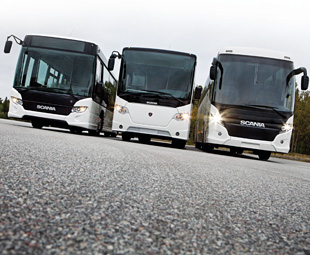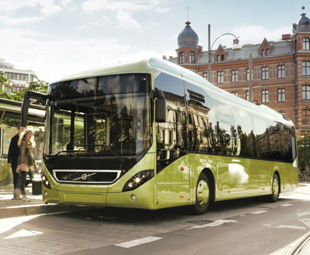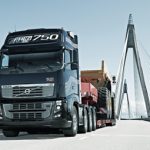Swedes steal the Kortrijk show

Scania and Volvo both launched important new models at the Busworld Kortrijk exhibition in Belgium, reports FRANK BEETON.
Scania used October’s Busworld Kortrijk exhibition in Belgium to exhibit new city bus and coach models. The Citywide LF (low floor) and Citywide LE (low entry) are new products intended for city and suburban operation, and are available with biodiesel, bioethanol and biogas fuel options.
The LF range comprises two-axle and articulated configurations, while the LE can be supplied in two-axle, three-axle (with hydraulically-steered trailing axle) or articulated formats. The LF has a rear-mounted transverse five-cylinder, 9,0-litre engine with a power range from 175 kW (230 hp) to 200 kW (270) hp, while the LE has the same basic engine in rear-mounted longitudinal format, delivering up to 225 kW (305 hp) when running on natural gas or biogas fuel.
Both models use a ZF fully-automatic five- or six-speed transmission, and the LE is also available with Scania’s own 12-speed Opticruise automated mechanical unit, with Scania Retarder.
The Scania OmniExpress 3.20 mid-decker coach is available in two- or thee-axled configurations, the latter employing a hydraulically-steered trailing axle. Power is provided by a rear-mounted longitudinal five- or six-cylinder engine, burning diesel, biodiesel or bioethanol fuels, with outputs ranging from 175 kW (230 hp) to 330 kW (440 hp), driving though a number of transmission options.
These include Scania’s 12-speed Opticruise (with Scania Retarder), the manufacturer’s own eight-speed manual gearbox with comfort Shift and retarder, or five- and six-speed ZF fully-automatic transmissions with integrated retarders.
The vehicle is available in 12 lengths, ranging from 11 m to 14,9 m, and three overall heights (standard 3,2 m, optional 3,4 m and 3,6 m) with accommodation for up to 71 passengers on the longest three-axle version.
The styling of the new Citywide and OmniExpress models has been influenced by Scania’s Touring HD high-decker coach, which is built in conjunction with Higer in Shanghai, China, and was first launched in 2009. Scania took the opportunity to re-expose the Touring design at Kortrijk, in order to demonstrate the family resemblance with the newer products.
The Touring specification includes a longitudinally-mounted five- or six-cylinder engine with a Euro-5 compliant output range of 270-360 kW (360-480 hp), driving through a fully-automated Opticruise 12-speed or Comfort Shift eight-speed manual transmission, and equipped with a Scania Retarder. This model is available in 12 m two-axle or 13,7 m three-axle (6×2) configurations.
Volvo launches low-floor city bus
Also on view at Busworld Kortrijk was Volvo’s new 7900 low-floor city bus. Similar in many respects to the Volvo 8900 short- to medium-distance intercity bus launched last year, the 7900 is claimed to offer a considerable mass saving over its predecessor (the 7700) and this has been achieved by using a mixture of materials in manufacturing the body structure. These include aluminium profiles, fiberglass, plastics and steel, and the assembly method makes extensive use of gluing and screwing – thus greatly simplifying maintenance and accident repairs once the bus has entered service.
 In addition to mass saving, which can be directly translated into greater carrying capacity, the 7900’s construction method is claimed to greatly reduce the potential for corrosion.
In addition to mass saving, which can be directly translated into greater carrying capacity, the 7900’s construction method is claimed to greatly reduce the potential for corrosion.
The Volvo 7900 is being offered in both 12-metre rigid or 18-metre two-element articulated formats, with diesel, gas or hybrid drivelines. The first two use versions of the manufacturer’s 9,0-litre engine, while the hybrid makes do with a 5,0-litre diesel unit, enabling even greater mass savings. The D9B diesel engine is Euro-5 compliant, while the G9B gas engine can operate on both Compressed Natural Gas and biogas.
Automatic transmissions from both ZF and Voith are offered on the conventional drive units, while the hybrid derivative combines Volvo’s I-shift automated transmission with an electric motor.
Volvo placed considerable emphasis on driver comfort and convenience in the 7900 design brief, and this has led to the development of an ergonomic driver’s seat and steering wheel, both of which offer a wide range of adjustments to accommodate tall and short drivers. Attention has also been paid to convenient control positioning and an unobstructed driver’s view, using three-way rearview mirrors and an optional rear camera.
Typically, safety was also high on the list of design parameters, and the 7900 structure complies with the European Union’s R66 rollover requirement, while additional protection is provided by electronically-controlled brakes, two or three-point passenger seatbelts, fire detectors with a sprinkler system, an integrated surveillance camera, and an alcohol safety interlock that keeps the brakes applied if the driver is intoxicated.
Published by
Focus on Transport
focusmagsa



